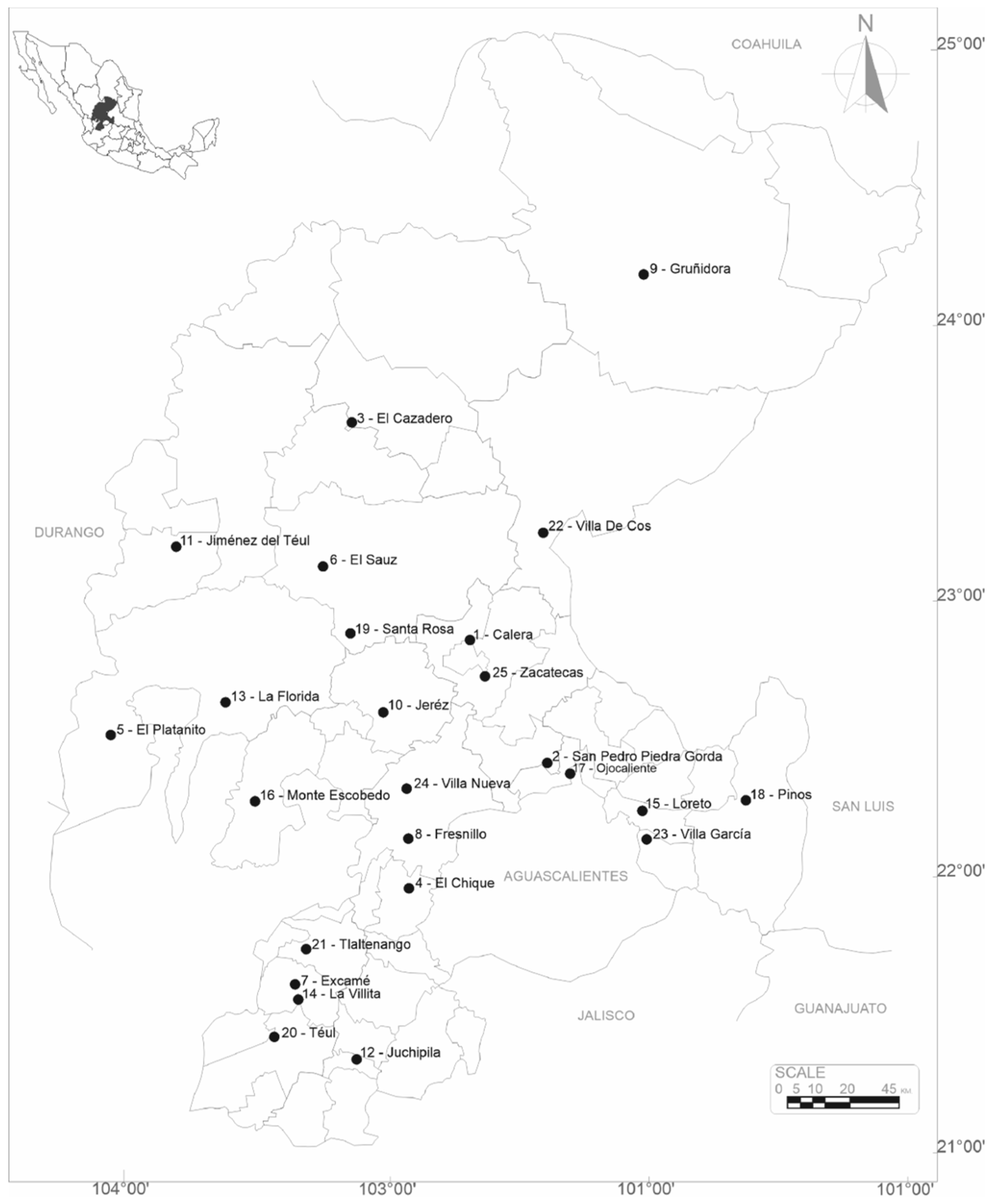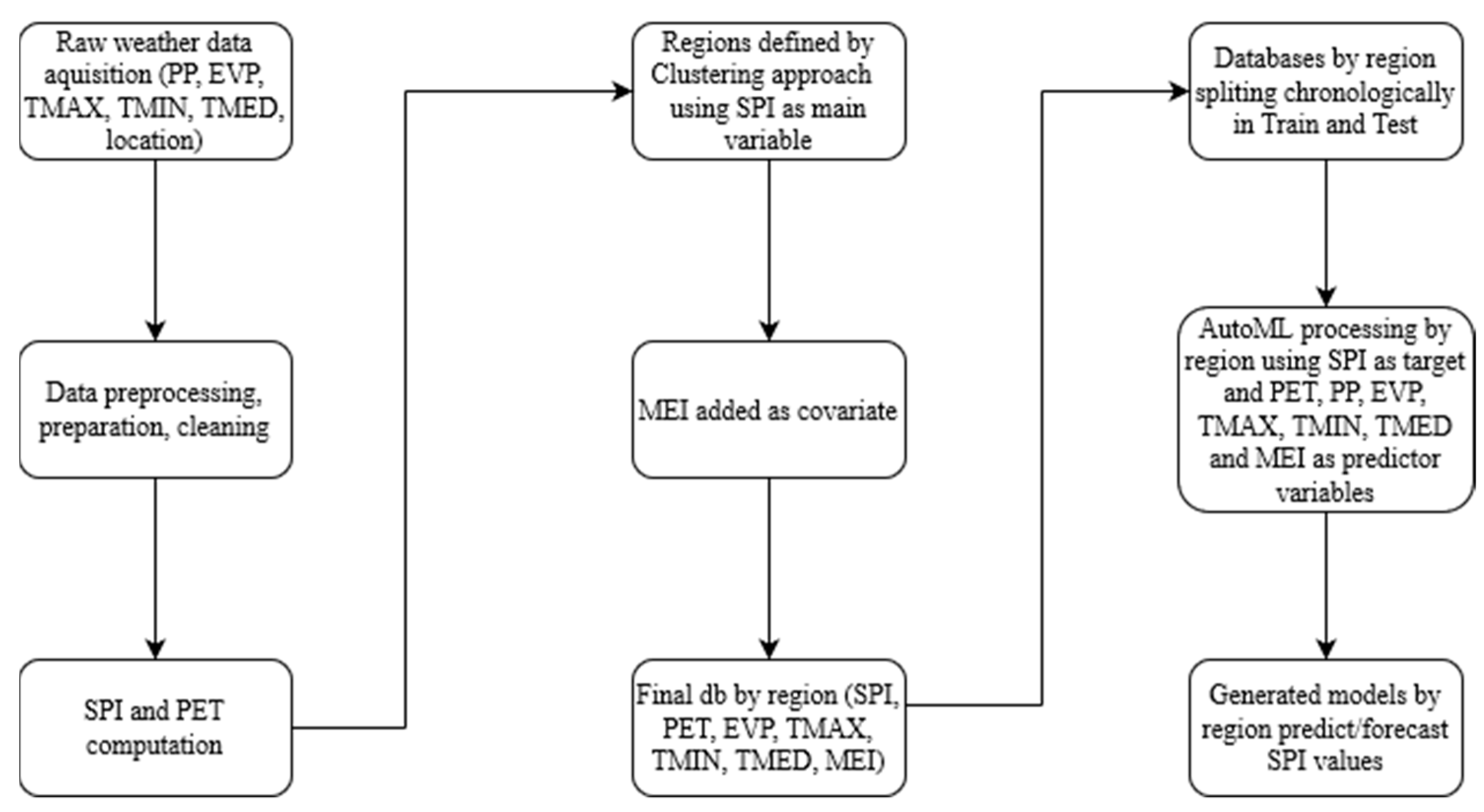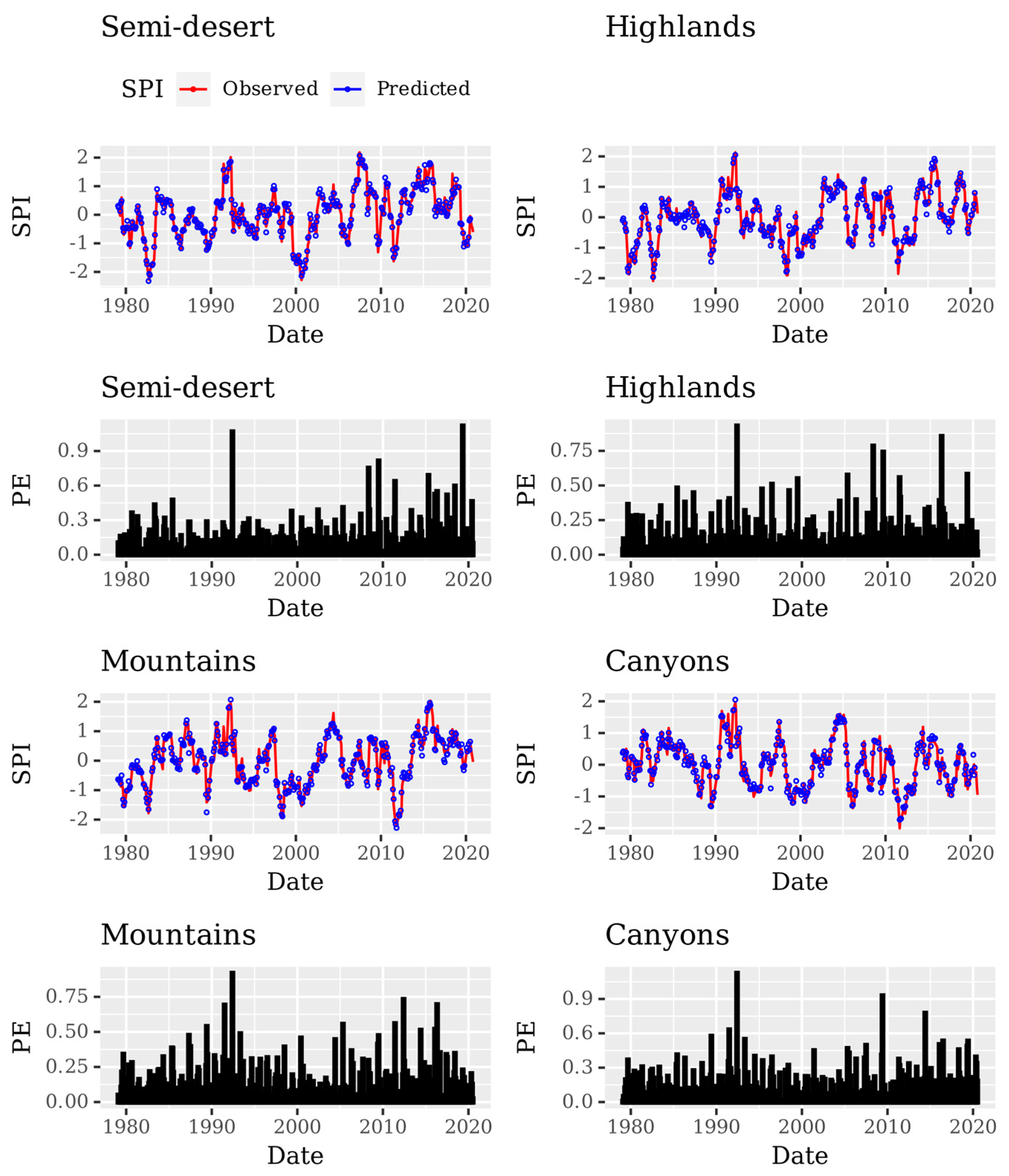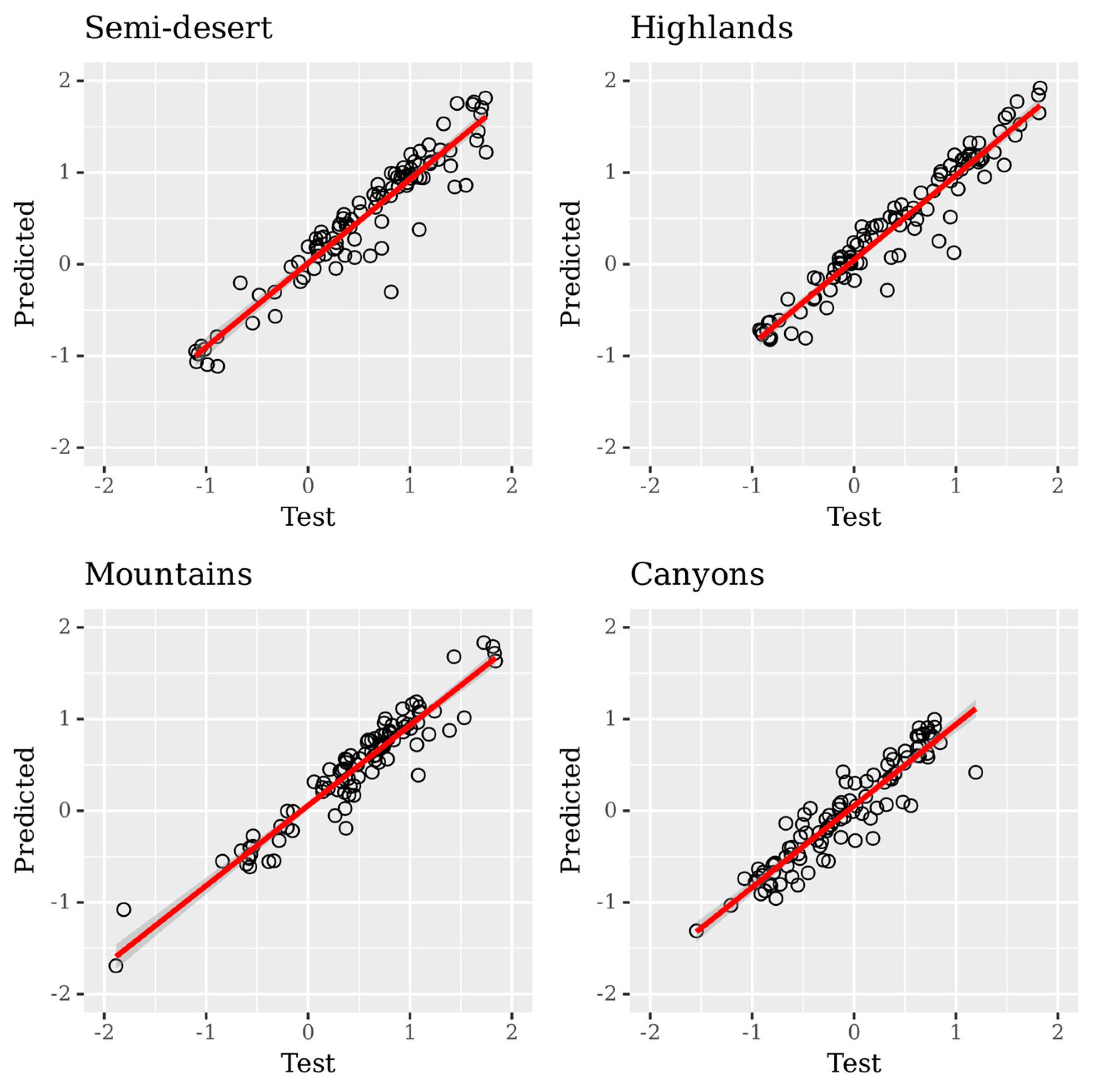Auto-Machine-Learning Models for Standardized Precipitation Index Prediction in North–Central Mexico
Abstract
1. Introduction
2. Materials and Methods
2.1. Data
2.2. Standardized Precipitation Index
2.3. Cluster Analysis
2.4. Potential Evapotranspiration Index
2.5. Multivariate ENSO Index Data
2.6. Linear Models for Time-Series Forecasting
2.7. Machine Learning for Time-Series Forecasting
2.7.1. Recurrent Neural Network
2.7.2. Long Short-Term Memory
2.7.3. Gated Recurrent Unit
2.7.4. Automated Machine Learning
- Data preprocessing: This involves cleaning and preparing the time-series data for analysis, such as handling missing values, outliers, and converting the data into a suitable format for modeling.
- Feature engineering: This step involves extracting relevant features from the time-series data to be used as input in the machine learning models.
- Model selection: In this step, prediction of the forthcoming values of the time series is achieved by evaluating and comparing different machine learning models for their performance.
- Hyperparameter tuning: This involves selecting the optimal values of hyperparameters for each machine learning model, which can significantly improve the model’s performance.
- Ensemble learning: This step involves combining multiple machine learning models to improve the prediction accuracy of the time-series data.
2.7.5. AutoML Frameworks
2.8. Performance Metrics
3. Results and Discussion
4. Conclusions
Author Contributions
Funding
Data Availability Statement
Conflicts of Interest
References
- Kharin, V.V.; Zwiers, F.W.; Zhang, X.; Hegerl, G.C. Changes in Temperature and Precipitation Extremes in the IPCC Ensemble of Global Coupled Model Simulations. J. Clim. 2007, 20, 1419–1444. [Google Scholar] [CrossRef]
- Angheluță, P.S.; Badea, C.G. The Water Resources in the Context of Climate Change Produced by the Greenhouse Gases. Ann. Univ. Oradea 2015, 1, 637–643. [Google Scholar]
- Choubin, B.; Malekian, A.; Golshan, M. Application of Several Data-Driven Techniques to Predict a Standardized Precipitation Index. Atmosfera 2016, 29, 121–128. [Google Scholar] [CrossRef]
- Ali, Z.; Hussain, I.; Faisal, M.; Nazir, H.M.; Hussain, T.; Shad, M.Y.; Mohamd Shoukry, A.; Hussain Gani, S. Forecasting Drought Using Multilayer Perceptron Artificial Neural Network Model. Adv. Meteorol. 2017, 2017, 5681308. [Google Scholar] [CrossRef]
- McKee, T.B.; Doesken, N.J.; Kleist, J. The Relationship of Drought Frequency and Duration to Time Scales. In Proceedings of the 8th Conference on Applied Climatology, Anaheim, CA, USA, 17–22 January 1993; Volume 17, pp. 179–183. [Google Scholar]
- Naresh Kumar, M.; Murthy, C.S.; Sesha Sai, M.V.R.; Roy, P.S. On the Use of Standardized Precipitation Index (SPI) for Drought Intensity Assessment. Meteorol. Appl. 2009, 16, 381–389. [Google Scholar] [CrossRef]
- Mahfouz, P.; Mitri, G.; Jazi, M.; Karam, F. Investigating the Temporal Variability of the Standardized Precipitation Index in Lebanon. Climate 2016, 4, 27. [Google Scholar] [CrossRef]
- Giddings, L.; Soto, M.; Rutherford, B.M.; Maarouf, A. Standardized Precipitation Index Zones for México. Atmosfera 2005, 18, 33–56. [Google Scholar]
- Magallanes-Quintanar, R.; Blanco-Macías, F.; Galván-Tejada, E.C.; Galván-Tejada, J.; Márquez-Madrid, M.; Valdez-Cepeda, R.D. Negative Regional Standardized Precipitation Index Trends Prevail in the Mexico’s State of Zacatecas. Terra Latinoam. 2019, 37, 487–499. [Google Scholar] [CrossRef]
- Poornima, S.; Pushpalatha, M. Drought Prediction Based on SPI and SPEI with Varying Timescales Using LSTM Recurrent Neural Network. Soft Comput. 2019, 23, 8399–8412. [Google Scholar] [CrossRef]
- Chen, L.; Han, B.; Wang, X.; Zhao, J.; Yang, W.; Yang, Z. Machine Learning Methods in Weather and Climate Applications: A Survey. Appl. Sci. 2023, 13, 12019. [Google Scholar] [CrossRef]
- Ozger, M.; Mishra, A.K.; Singh, V.P. Estimating Palmer Drought Severity Index Using a Wavelet Fuzzy Logic Model Based on Meteorological Variables. Int. J. Climatol. 2011, 31, 2021–2032. [Google Scholar] [CrossRef]
- Masinde, M. Artificial Neural Networks Models for Predicting Effective Drought Index: Factoring Effects of Rainfall Variability. Mitig. Adapt. Strateg. Glob. Chang. 2014, 19, 1139–1162. [Google Scholar] [CrossRef]
- Belayneh, A.; Adamowski, J.; Khalil, B.; Ozga-Zielinski, B. Long-Term SPI Drought Forecasting in the Awash River Basin in Ethiopia Using Wavelet Neural Network and Wavelet Support Vector Regression Models. J. Hydrol. 2014, 508, 418–429. [Google Scholar] [CrossRef]
- Deo, R.C.; Şahin, M. Application of the Artificial Neural Network Model for Prediction of Monthly Standardized Precipitation and Evapotranspiration Index Using Hydrometeorological Parameters and Climate Indices in Eastern Australia. Atmos. Res. 2015, 161–162, 65–81. [Google Scholar] [CrossRef]
- Soh, Y.W.; Koo, C.H.; Huang, Y.F.; Fung, K.F. Application of Artificial Intelligence Models for the Prediction of Standardized Precipitation Evapotranspiration Index (SPEI) at Langat River Basin, Malaysia. Comput. Electron. Agric. 2018, 144, 164–173. [Google Scholar] [CrossRef]
- Magallanes-Quintanar, R.; Galván-Tejada, C.E.; Galvan-Tejada, J.I.; de Jesús Méndez-Gallegos, S.; Blanco-Macías, F.; Valdez-Cepeda, R.D. Artificial Neural Network Models for Prediction of Standardized Precipitation Index in Central Mexico. Agrociencia 2023, 57, 11–20. [Google Scholar] [CrossRef]
- LeDell, E.; Poirier, S. H2O AutoML: Scalable Automatic Machine Learning. In Proceedings of the 7th AutoML Workshop at ICML, San Diego, CA, USA, 17–18 July 2020; Volume 2020. [Google Scholar]
- Thornthwaite, C.W. An Approach toward a Rational Classification of Climate. Geogr. Rev. 1948, 38, 55–94. [Google Scholar] [CrossRef]
- Caloiero, T. Drought Analysis in New Zealand Using the Standardized Precipitation Index. Environ. Earth Sci. 2017, 76, 569. [Google Scholar] [CrossRef]
- Beguería, S.; Vicente-Serrano, S.M. SPEI: Calculation of the Standardized Precipitation-Evapotranspiration Index. In R Package Version 2017; R Foundation for Statistical Computing: Vienna, Austria, 2017; Volume 1. [Google Scholar]
- R Core Team. R: A Language and Environment for Statistical Computing; R Foundation for Statistical Computing: Vienna, Austria, 2013. [Google Scholar]
- Unal, Y.; Kindap, T.; Karaca, M. Redefining the Climate Zones of Turkey Using Cluster Analysis. Int. J. Climatol. 2003, 23, 1045–1055. [Google Scholar] [CrossRef]
- Karmalkar, A.V.; Bradley, R.S.; Diaz, H.F. Climate Change in Central America and Mexico: Regional Climate Model Validation and Climate Change Projections. Clim. Dyn. 2011, 37, 605–629. [Google Scholar] [CrossRef]
- Paradis, E.; Schliep, K. Ape 5.0: An Environment for Modern Phylogenetics and Evolutionary Analyses in R. Bioinformatics 2019, 35, 526–528. [Google Scholar] [CrossRef] [PubMed]
- Hanson, R.L. Evapotranspiration and Droughts. In National Water Summary 1988–89—Hydrologic Events and Floods and Droughts: US Geological Survey Water-Supply Paper; Le Haut Commissariat aux Eaux et Forêts: El Haj Kaddour, Morocco, 1991; Volume 2375. [Google Scholar]
- Vicente-Serrano, S.M.; Beguería, S.; López-Moreno, J.I. A Multiscalar Drought Index Sensitive to Global Warming: The Standardized Precipitation Evapotranspiration Index. J. Clim. 2010, 23, 1696–1718. [Google Scholar] [CrossRef]
- Wolter, K.; Timlin, M.S. Measuring the Strength of ENSO Events: How Does 1997/98 Rank? Weather 1998, 53, 315–324. [Google Scholar] [CrossRef]
- Wolter, K.; Timlin, M.S. El Niño/Southern Oscillation Behaviour since 1871 as Diagnosed in an Extended Multivariate ENSO Index (MEI.Ext). Int. J. Climatol. 2011, 31, 1074–1087. [Google Scholar] [CrossRef]
- Madsen, H. Time Series Analysis; Chapman and Hall/CRC: Boca Raton, FL, USA, 2007; ISBN 0-429-19583-4. [Google Scholar]
- Rumelhart, D.E.; Hinton, G.E.; Williams, R.J. Learning Representations by Back-Propagating Errors. Nature 1986, 323, 533–536. [Google Scholar] [CrossRef]
- Hochreiter, S.; Schmidhuber, J. Long Short-Term Memory. Neural Comput. 1997, 9, 1735–1780. [Google Scholar] [CrossRef] [PubMed]
- Cho, K.; Van Merriënboer, B.; Gulcehre, C.; Bahdanau, D.; Bougares, F.; Schwenk, H.; Bengio, Y. Learning Phrase Representations Using RNN Encoder-Decoder for Statistical Machine Translation. arXiv 2014, arXiv:1406.1078. [Google Scholar]
- Feurer, M.; Klein, A.; Eggensperger, K.; Springenberg, J.; Blum, M.; Hutter, F. Efficient and Robust Automated Machine Learning. Adv. Neural Inf. Process. Syst. 2015, 28, 2755–2763. [Google Scholar]
- Alsharef, A.; Aggarwal, K.; Kumar, M.; Mishra, A. Review of ML and AutoML Solutions to Forecast Time-Series Data. Arch. Comput. Methods Eng. 2022, 29, 5297–5311. [Google Scholar] [CrossRef]
- Olson, R.S.; Urbanowicz, R.J.; Andrews, P.C.; Lavender, N.A.; Kidd, L.C.; Moore, J.H. Automating Biomedical Data Science through Tree-Based Pipeline Optimization. In Proceedings of the 19th European Conference on the Applications of Evolutionary Computation, EvoApplications 2016, Porto, Portugal, 30 March–1 April 2016; Springer: Berlin/Heidelberg, Germany, 2016. Part I 19. pp. 123–137. [Google Scholar]
- Erickson, N.; Mueller, J.; Shirkov, A.; Zhang, H.; Larroy, P.; Li, M.; Smola, A. Autogluon-Tabular: Robust and Accurate Automl for Structured Data. arXiv 2020, arXiv:2003.06505. [Google Scholar]
- Paldino, G.M.; De Stefani, J.; De Caro, F.; Bontempi, G. Does AutoML Outperform Naive Forecasting? Eng. Proc. 2021, 5, 36. [Google Scholar] [CrossRef]
- Van Rossum, G.; Drake, F.L. Introduction to Python 3: Python Documentation Manual Part 1; CreateSpace: Scotts Valley, CA, USA, 2009; ISBN 1-4414-1270-0. [Google Scholar]
- H2O AutoML: Automatic Machine Learning. Available online: https://docs.h2o.ai/h2o/latest-stable/h2o-docs/automl.html (accessed on 28 June 2024).
- Moustris, K.P.; Larissi, I.K.; Nastos, P.T.; Paliatsos, A.G. Precipitation Forecast Using Artificial Neural Networks in Specific Regions of Greece. Water Resour. Manag. 2011, 25, 1979–1993. [Google Scholar] [CrossRef]
- Daliakopoulos, I.N.; Coulibaly, P.; Tsanis, I.K. Groundwater Level Forecasting Using Artificial Neural Networks. J. Hydrol. 2005, 309, 229–240. [Google Scholar] [CrossRef]
- Farajzadeh, J.; Fakheri Fard, A.; Lotfi, S. Modeling of Monthly Rainfall and Runoff of Urmia Lake Basin Using “Feed-Forward Neural Network” and “Time Series Analysis” Model. Water Resour. Ind. 2014, 7–8, 38–48. [Google Scholar] [CrossRef]
- Snieder, E.; Shakir, R.; Khan, U.T. A Comprehensive Comparison of Four Input Variable Selection Methods for Artificial Neural Network Flow Forecasting Models. J. Hydrol. 2020, 583, 124299. [Google Scholar] [CrossRef]
- Sharma, P.; Singh, S.; Sharma, S.D. Artificial Neural Network Approach for Hydrologic River Flow Time Series Forecasting. Agric. Res. 2022, 11, 465–476. [Google Scholar] [CrossRef]
- Bouaziz, M.; Medhioub, E.; Csaplovisc, E. A Machine Learning Model for Drought Tracking and Forecasting Using Remote Precipitation Data and a Standardized Precipitation Index from Arid Regions. J. Arid Environ. 2021, 189, 104478. [Google Scholar] [CrossRef]




| SPI Value | Category |
|---|---|
| ≥2.0 | Extremely wet |
| 1.5 to 1.99 | Severely wet |
| 1.0 to 1.49 | Moderately wet |
| −0.99 to 0.99 | Near normal |
| −1.49 to −0.99 | Moderately drought |
| −1.99 to −1.49 | Severely drought |
| ≤2.0 | Extremely drought |
| Region | Predictors | |||||
|---|---|---|---|---|---|---|
| Semi-Arid | PP (mm) | EVP (mm) | TMED (°C) | TMIN (°C) | TMAX (°C) | PET (mm) |
| Min | 0.00 | 58.00 | 10.05 | −6.00 | 21.00 | 25.19 |
| Mean | 38.89 | 160.17 | 16.37 | 4.25 | 28.41 | 63.92 |
| Max | 339.50 | 299.90 | 21.36 | 11.50 | 42.06 | 105.22 |
| SD | 45.08 | 50.79 | 2.68 | 4.14 | 2.83 | 20.96 |
| Highlands | PP (mm) | EVP (mm) | TMED (°C) | TMIN (°C) | TMAX (°C) | PET (mm) |
| Min | 0.00 | 91.91 | 9.98 | −10.91 | 23.47 | 23.656 |
| Mean | 37.63 | 167.84 | 16.67 | 3.39 | 29.24 | 66.64 |
| Max | 275.56 | 308.82 | 22.51 | 11.32 | 35.54 | 114.41 |
| SD | 42.42 | 48.13 | 3.25 | 5.02 | 2.68 | 25.42 |
| Mountains | PP (mm) | EVP (mm) | TMED (°C) | TMIN (°C) | TMAX (°C) | PET (mm) |
| Min | 0.00 | 81.27 | 11.31 | −6.42 | 25.32 | 25.29 |
| Mean | 47.22 | 166.44 | 18.18 | 4.39 | 31.57 | 74.30 |
| Max | 295.42 | 308.95 | 24.73 | 12.70 | 39.00 | 144.71 |
| SD | 54.72 | 54.54 | 3.39 | 5.18 | 2.91 | 30.78 |
| Canyons | PP (mm) | EVP (mm) | TMED (°C) | TMIN (°C) | TMAX (°C) | PET (mm) |
| Min | 0.00 | 83.28 | 11.35 | −5.43 | 24.30 | 26.54 |
| Mean | 53.55 | 156.84 | 18.50 | 4.63 | 31.74 | 72.97 |
| Max | 331.46 | 285.04 | 25.56 | 13.10 | 39.30 | 139.98 |
| SD | 62.17 | 47.83 | 3.32 | 5.13 | 2.89 | 29.02 |
| Region | T | CV | T | CV | T | CV |
|---|---|---|---|---|---|---|
| MSE | MAE | R2 | ||||
| Semi-desert | 0.0296 | 0.0615 | 0.1214 | 0.1726 | 0.9584 | 0.9136 |
| Highlands | 0.0345 | 0.0503 | 0.127 | 0.1534 | 0.9426 | 0.9163 |
| Mountains | 0.0348 | 0.0557 | 0.1277 | 0.1632 | 0.9468 | 0.9149 |
| Canyons | 0.0388 | 0.0549 | 0.1355 | 0.1637 | 0.9342 | 0.9067 |
| Region | β0 | β1 | R2 | R |
|---|---|---|---|---|
| Semi-desert | 0.046 | 0.980 | 0.897 | 0.947 |
| Highlands | −0.020 | 1.008 | 0.930 | 0.964 |
| Mountains | −0.020 | 1.050 | 0.923 | 0.961 |
| Canyons | −0.066 | 0.981 | 0.871 | 0.933 |
| Region | PE < 0 | PE > 0 |
|---|---|---|
| Semi-desert | 0.4068 | 0.5932 |
| Highlands | 0.5339 | 0.4661 |
| Mountains | 0.4900 | 0.5100 |
| Canyons | 0.6200 | 0.3800 |
Disclaimer/Publisher’s Note: The statements, opinions and data contained in all publications are solely those of the individual author(s) and contributor(s) and not of MDPI and/or the editor(s). MDPI and/or the editor(s) disclaim responsibility for any injury to people or property resulting from any ideas, methods, instructions or products referred to in the content. |
© 2024 by the authors. Licensee MDPI, Basel, Switzerland. This article is an open access article distributed under the terms and conditions of the Creative Commons Attribution (CC BY) license (https://creativecommons.org/licenses/by/4.0/).
Share and Cite
Magallanes-Quintanar, R.; Galván-Tejada, C.E.; Galván-Tejada, J.I.; Gamboa-Rosales, H.; Méndez-Gallegos, S.d.J.; García-Domínguez, A. Auto-Machine-Learning Models for Standardized Precipitation Index Prediction in North–Central Mexico. Climate 2024, 12, 102. https://doi.org/10.3390/cli12070102
Magallanes-Quintanar R, Galván-Tejada CE, Galván-Tejada JI, Gamboa-Rosales H, Méndez-Gallegos SdJ, García-Domínguez A. Auto-Machine-Learning Models for Standardized Precipitation Index Prediction in North–Central Mexico. Climate. 2024; 12(7):102. https://doi.org/10.3390/cli12070102
Chicago/Turabian StyleMagallanes-Quintanar, Rafael, Carlos E. Galván-Tejada, Jorge Isaac Galván-Tejada, Hamurabi Gamboa-Rosales, Santiago de Jesús Méndez-Gallegos, and Antonio García-Domínguez. 2024. "Auto-Machine-Learning Models for Standardized Precipitation Index Prediction in North–Central Mexico" Climate 12, no. 7: 102. https://doi.org/10.3390/cli12070102
APA StyleMagallanes-Quintanar, R., Galván-Tejada, C. E., Galván-Tejada, J. I., Gamboa-Rosales, H., Méndez-Gallegos, S. d. J., & García-Domínguez, A. (2024). Auto-Machine-Learning Models for Standardized Precipitation Index Prediction in North–Central Mexico. Climate, 12(7), 102. https://doi.org/10.3390/cli12070102








